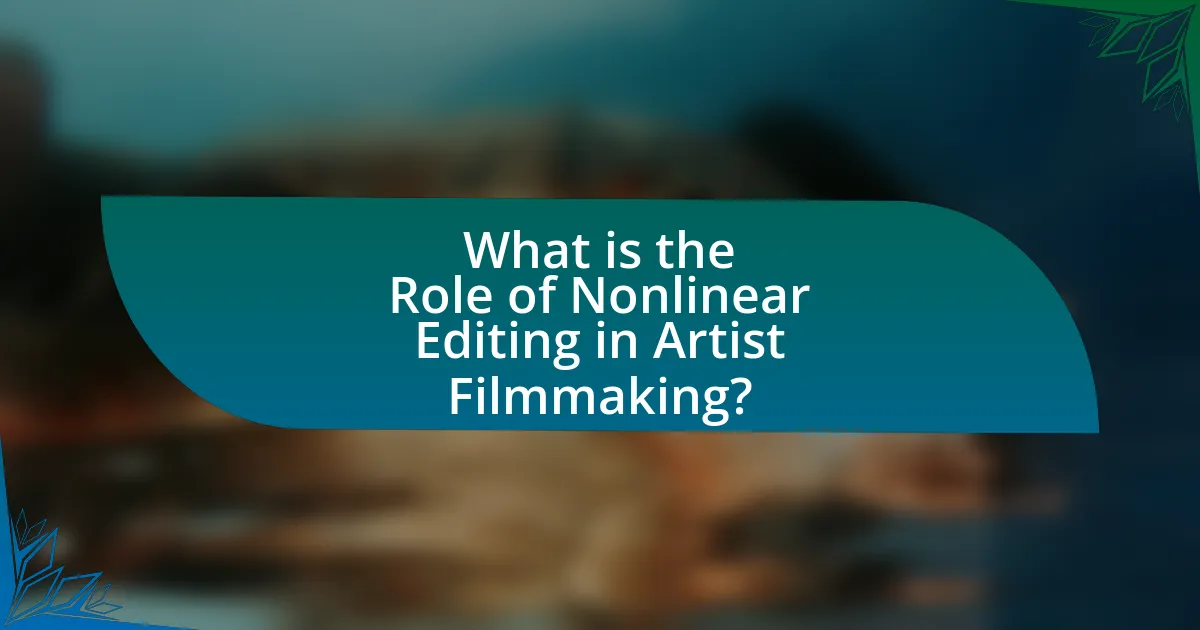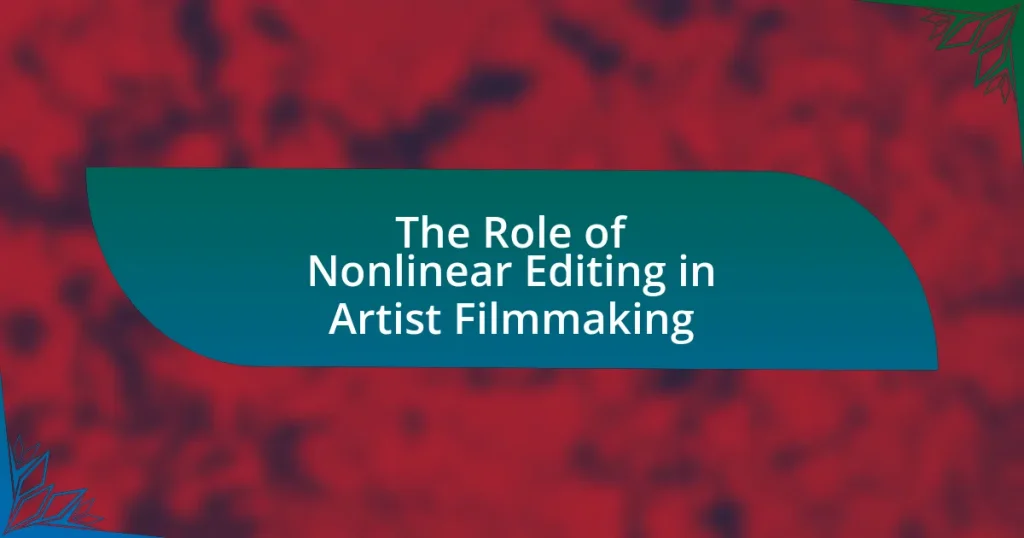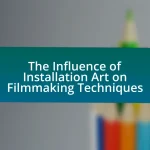Nonlinear editing is a pivotal technique in artist filmmaking that offers filmmakers enhanced flexibility and creative control over their editing processes. This article explores the distinctions between nonlinear and traditional editing methods, highlighting the key features and advantages of nonlinear systems, such as real-time editing and non-destructive workflows. It also examines how nonlinear editing fosters experimentation and innovation, influences storytelling techniques, and impacts audience engagement. Additionally, the article addresses the challenges artist filmmakers may face with nonlinear editing and provides best practices and tips for optimizing the editing process to achieve better results.

What is the Role of Nonlinear Editing in Artist Filmmaking?
Nonlinear editing plays a crucial role in artist filmmaking by providing flexibility and creative control over the editing process. This editing technique allows filmmakers to access any frame of the digital video file in any order, enabling them to experiment with narrative structures, pacing, and visual aesthetics without the constraints of linear editing systems. For instance, nonlinear editing software like Adobe Premiere Pro and Final Cut Pro has become standard tools in the industry, facilitating innovative storytelling methods and enhancing the artistic expression of filmmakers. This capability is particularly significant in artist filmmaking, where the exploration of unconventional narratives and visual styles is often essential to the work’s impact and meaning.
How does nonlinear editing differ from traditional editing methods?
Nonlinear editing differs from traditional editing methods primarily in its non-sequential approach to arranging video clips. In nonlinear editing, editors can access any frame of the digital video file at any time, allowing for greater flexibility and creativity in the editing process. This contrasts with traditional editing, which typically requires a linear sequence, where edits are made in a fixed order, often necessitating the physical cutting and splicing of film. Nonlinear editing systems, such as Avid Media Composer or Adobe Premiere Pro, enable real-time editing and the ability to easily rearrange scenes, apply effects, and manage multiple audio tracks, which enhances the efficiency and creative possibilities for filmmakers.
What are the key features of nonlinear editing systems?
Nonlinear editing systems are characterized by their ability to allow users to access any frame in a digital video clip regardless of the sequence in which it was recorded. Key features include non-destructive editing, which preserves the original footage; real-time playback, enabling immediate viewing of edits; and a user-friendly interface that facilitates intuitive navigation and manipulation of video clips. Additionally, these systems support a wide range of formats and resolutions, enabling flexibility in project requirements. The integration of advanced effects and transitions further enhances creative possibilities, making nonlinear editing essential for modern filmmaking.
How does nonlinear editing enhance creative expression in filmmaking?
Nonlinear editing enhances creative expression in filmmaking by allowing filmmakers to manipulate and arrange footage in a non-sequential manner, which fosters greater artistic freedom. This editing approach enables the exploration of various narrative structures, pacing, and visual styles without the constraints of linear editing. For instance, filmmakers can easily experiment with different scenes, transitions, and effects, facilitating innovative storytelling techniques. The flexibility of nonlinear editing software, such as Adobe Premiere Pro or Final Cut Pro, supports real-time adjustments and instant playback, which encourages spontaneous creativity and iterative processes. This capability has been pivotal in the evolution of modern filmmaking, as evidenced by films like “Pulp Fiction,” where nonlinear storytelling significantly contributes to the narrative’s impact and viewer engagement.
Why is nonlinear editing important for artist filmmakers?
Nonlinear editing is important for artist filmmakers because it provides flexibility and creative control over the editing process. This editing approach allows filmmakers to access any part of their footage at any time, enabling them to experiment with different sequences and styles without the constraints of linear editing. For instance, artist filmmakers can easily rearrange scenes, incorporate various visual effects, and refine their narratives, which enhances their ability to express complex artistic visions. The ability to make real-time adjustments and see immediate results fosters a more dynamic and iterative creative process, ultimately leading to more innovative and personalized films.
What advantages does nonlinear editing provide in the artistic process?
Nonlinear editing offers significant advantages in the artistic process by allowing creators to manipulate and arrange video and audio elements freely without the constraints of a linear timeline. This flexibility enables artists to experiment with different sequences, making it easier to explore creative ideas and refine narratives. For instance, nonlinear editing software like Adobe Premiere Pro and Final Cut Pro allows for instant access to any part of the project, facilitating quick adjustments and iterations. This capability enhances the artistic workflow, as artists can easily test various edits and transitions, ultimately leading to a more polished final product.
How does nonlinear editing facilitate experimentation and innovation?
Nonlinear editing facilitates experimentation and innovation by allowing filmmakers to manipulate and rearrange footage freely without the constraints of a linear timeline. This flexibility enables artists to explore various narrative structures, test different visual styles, and rapidly iterate on their ideas, fostering a creative environment where unconventional approaches can thrive. For instance, software like Adobe Premiere Pro and Final Cut Pro provides tools for real-time editing and instant playback, which encourages filmmakers to experiment with pacing and transitions, ultimately leading to innovative storytelling techniques.
What challenges do artist filmmakers face when using nonlinear editing?
Artist filmmakers face several challenges when using nonlinear editing, primarily related to the complexity of the editing process and the need for a clear artistic vision. The nonlinear editing system allows for greater flexibility and creativity, but this can lead to overwhelming choices and potential confusion about narrative structure. Additionally, artist filmmakers often struggle with the technical aspects of the software, which can hinder their ability to realize their creative intentions effectively. Research indicates that a lack of technical proficiency can result in increased editing time and frustration, ultimately impacting the quality of the final product. Furthermore, the collaborative nature of many artistic projects can complicate the editing process, as differing visions among team members may lead to conflicts and delays.
What technical skills are required for effective nonlinear editing?
Effective nonlinear editing requires proficiency in software tools, understanding of video formats, and knowledge of audio editing techniques. Proficiency in software such as Adobe Premiere Pro, Final Cut Pro, or Avid Media Composer is essential, as these platforms facilitate the editing process through various features like timeline manipulation and effects application. Understanding video formats, including codecs and resolutions, is crucial for ensuring compatibility and quality in the final output. Additionally, knowledge of audio editing techniques, such as sound mixing and synchronization, enhances the overall production quality. These skills collectively enable editors to create cohesive and engaging narratives in artist filmmaking.
How can artist filmmakers overcome common obstacles in nonlinear editing?
Artist filmmakers can overcome common obstacles in nonlinear editing by utilizing structured workflows and effective software tools. Implementing a clear organizational system for media assets, such as consistent naming conventions and folder structures, helps streamline the editing process. Additionally, leveraging advanced features in nonlinear editing software, like proxy editing for high-resolution files, can significantly reduce rendering times and improve performance. Research indicates that a well-defined editing workflow can enhance productivity by up to 30%, allowing filmmakers to focus more on creative aspects rather than technical challenges.
How does nonlinear editing influence storytelling in artist filmmaking?
Nonlinear editing significantly influences storytelling in artist filmmaking by allowing creators to manipulate narrative structure and pacing more freely. This editing technique enables filmmakers to rearrange scenes, integrate multiple timelines, and juxtapose contrasting imagery, which enhances thematic depth and emotional resonance. For instance, films like “Memento” by Christopher Nolan utilize nonlinear editing to create suspense and engage viewers in piecing together the narrative puzzle, demonstrating how this approach can transform audience perception and interpretation. The flexibility of nonlinear editing thus empowers artist filmmakers to explore complex narratives that challenge traditional storytelling conventions.
What narrative techniques can be enhanced through nonlinear editing?
Nonlinear editing enhances several narrative techniques, including non-chronological storytelling, thematic juxtaposition, and character development. Non-chronological storytelling allows filmmakers to present events out of sequence, creating suspense and engaging the audience’s curiosity. Thematic juxtaposition enables the combination of disparate scenes to highlight contrasts or parallels, enriching the narrative’s depth. Additionally, nonlinear editing facilitates character development by allowing for flashbacks or flash-forwards that reveal motivations and backstories, thus providing a more nuanced understanding of characters. These enhancements are supported by the flexibility and creative control that nonlinear editing software offers, allowing artists to experiment with structure and pacing effectively.
How does nonlinear editing affect audience engagement and perception?
Nonlinear editing significantly enhances audience engagement and perception by allowing for a more dynamic and interactive storytelling experience. This editing technique enables filmmakers to manipulate narrative structure, pacing, and visual elements, which can evoke stronger emotional responses from viewers. For instance, studies have shown that nonlinear narratives can increase cognitive engagement, as audiences actively piece together the storyline, leading to a deeper investment in the content. Research published in the Journal of Media Psychology indicates that nonlinear editing can create suspense and intrigue, ultimately influencing how viewers interpret and connect with the film’s themes.
What tools and software are commonly used in nonlinear editing for artist filmmakers?
Common tools and software used in nonlinear editing for artist filmmakers include Adobe Premiere Pro, Final Cut Pro, Avid Media Composer, and DaVinci Resolve. These platforms are widely recognized for their robust editing capabilities, allowing filmmakers to manipulate video and audio with precision. For instance, Adobe Premiere Pro is favored for its integration with other Adobe Creative Cloud applications, enhancing workflow efficiency. Final Cut Pro is known for its user-friendly interface and powerful features tailored for Mac users. Avid Media Composer is often utilized in professional environments due to its advanced collaborative tools. DaVinci Resolve stands out for its color grading capabilities, making it a preferred choice for artists focusing on visual aesthetics.
What are the most popular nonlinear editing software options available?
The most popular nonlinear editing software options available include Adobe Premiere Pro, Final Cut Pro, Avid Media Composer, DaVinci Resolve, and HitFilm Express. Adobe Premiere Pro is widely used in the industry for its versatility and integration with other Adobe products. Final Cut Pro is favored by many Mac users for its user-friendly interface and powerful features. Avid Media Composer is a standard in professional film and television editing, known for its robust media management capabilities. DaVinci Resolve combines editing and color correction, making it a preferred choice for colorists. HitFilm Express offers a free version with advanced features, appealing to independent filmmakers and hobbyists. These software options are recognized for their effectiveness in various editing tasks, making them essential tools in artist filmmaking.
How do different tools impact the editing workflow for artists?
Different tools significantly enhance the editing workflow for artists by streamlining processes and improving efficiency. For instance, nonlinear editing software allows artists to manipulate video clips in a non-sequential manner, enabling quick adjustments and creative experimentation without the constraints of traditional linear editing. This flexibility is supported by features such as drag-and-drop functionality, real-time previews, and the ability to easily integrate various media formats. Research indicates that artists using advanced editing tools report a 30% increase in productivity due to reduced time spent on technical tasks, allowing more focus on creative expression.
What best practices should artist filmmakers follow when utilizing nonlinear editing?
Artist filmmakers should prioritize organization and planning when utilizing nonlinear editing. This involves creating a clear structure for their footage, such as using bins and folders to categorize clips by scenes or themes, which enhances workflow efficiency. Additionally, they should leverage the flexibility of nonlinear editing to experiment with different narrative structures and pacing, allowing for creative exploration without the constraints of linear editing. Regularly saving and backing up projects is crucial to prevent data loss, as nonlinear editing can involve extensive revisions. Furthermore, utilizing markers and notes within the editing software can help track ideas and maintain focus on the artistic vision throughout the editing process. These practices collectively enhance the editing experience and contribute to a more cohesive final product.
How can artist filmmakers optimize their editing process for better results?
Artist filmmakers can optimize their editing process for better results by utilizing nonlinear editing software that allows for flexible and efficient manipulation of footage. This approach enables filmmakers to easily rearrange scenes, apply effects, and experiment with different narratives without the constraints of linear editing methods. Research indicates that nonlinear editing systems significantly enhance creative workflows, as they provide tools for real-time collaboration and instant playback, which can lead to more innovative storytelling. For instance, a study by the University of Southern California found that filmmakers using nonlinear editing reported a 30% increase in productivity and creativity compared to traditional methods.
What tips can enhance the creative potential of nonlinear editing?
To enhance the creative potential of nonlinear editing, filmmakers should embrace experimentation with various editing techniques and software features. Utilizing tools such as layering, transitions, and effects can lead to innovative storytelling methods. For instance, the use of jump cuts or unconventional transitions can create a unique narrative flow that captivates the audience. Additionally, incorporating sound design and music in tandem with visual edits can significantly elevate the emotional impact of the film. Research indicates that nonlinear editing allows for greater flexibility and creativity, enabling artists to explore multiple narrative paths and visual styles, ultimately resulting in a more engaging final product.


